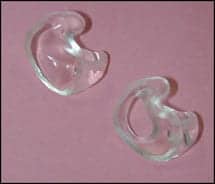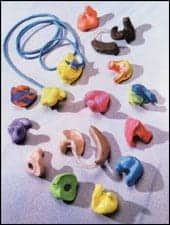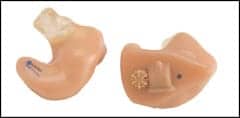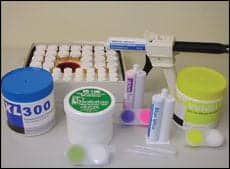Just as no two ears are exactly alike, it can be said that the ear impression techniques of any two hearing health care professionals can differ—especially with the varieties of materials, styles, methods, and options that come together to make what is one of the most important elements in the fitting of a hearing aid system.
That’s no exaggeration. The earmold must routinely and simultaneously fulfill a variety of functions:
- Provide a satisfactory acoustic seal;
- Acoustically couple the hearing aid to the ear;
- Retain the hearing aid on the auricle;
- Modify the signal produced by the hearing aid;
- Be comfortable to wear for an extended period of time;
- Be aesthetically acceptable to the patient; and
- Be of a style that the patient can physically handle.
Should the earmold fail in just one of those tasks, the hearing aid fitting can fail. So from A to V (acrylic to venting), let’s take a look at what goes into the making of this crucial component, and who’s making them.

|
| Mid-States earmolds |
MATERIAL WORLD
An earmold is an individually fabricated insert that channels the sound reproduced by a hearing aid receiver to the eardrum. Before deciding on the earmold style and material, several considerations must be kept in mind. The evaluation should include: severity and type of the patient’s hearing loss, anatomical properties of the ear, patient’s manual dexterity, allergic conditions, personal preferences, and difficulty with any previous hearing instrument fitting.
Earmold manufacturers have their own exclusive brand names such as 57-year-old Mid-States Laboratories, Wichita, Kan (800/247-3669; www.mid-stateslabs.com), which touts its bacteriostatic NASA-based Audtex-85 and Apollo-95 earmold materials, but generally speaking most fall into three categories:
- Acrylic/lucite
- Polyvinylchloride (PVC)
- Silicone
With its diversified range of products and technologies offered, Insta-Mold Products, Oaks, Pa (800/523-4081; www.instamold.com), is far more than an earmold company, and unique in the industry in that it manufactures its own silicones for direct sale to hearing health care professionals as part of its Insta-Mold Process, allowing them to make a custom swimplug, earmold, or noise protector in only minutes.

|
| Insta-Mold products |
A SENSE OF CLOSURE
Occluding earmolds are generally made into two styles, concha and canal. Concha earmolds occupy the ear concha and canal, whereas canal styles occupy the cavum concha, fitting in the canal aperture. Within those formats, there are typically several substyles: standard, shell, skeleton, and canal, and their variations. Shell molds are used with BTE aids and offer a broad fitting range covering moderate to profound hearing losses. Skeleton earmolds are a popular choice for patients with a mild to moderate hearing loss when an inconspicuous mold is desired. It effectively provides a good seal while allowing the concha to be relatively open for greater airflow in the bowl of the ear.
Hocks Hearing Healthcare Products, Portland, Ore (800/654-6257; www.hocksproducts.com), offers a wide variety of lucite earmolds in a variety of substyles, including half-skeleton, canal lock, cross-skeleton, standard, and phantom.
Perfect Seal Laboratories Inc, Wichita, Kan (800/311-9810; www.perfect-seal.com), was founded in 1999 and manufactures quality earmolds for businesses around the country. The company features an extensive line of standard earmolds including its Flex-In Mold, which addresses problem fittings brought about by mandibular movement that cause problems with seat or comfort. The aperture of the mold is hollowed out, allowing it to “flex-in” with the changing contours of the ear canal during jaw movement. Available in full-shell, half-shell, and canal-style molds.
Amplisound Hearing Products & Services, Danielson, Conn (800/835-2001; www.amplisound.com), has developed a micro BTE product line that features an optional skeleton open canal custom earmold. Constructed of a UV acrylic with a slight flex, it allows for a thinner, less occluding fit while also being less prone to breakage.

|
| Perfect Seal custom shells |
Non-occluding earmolds such as the two offered by Starkey Laboratories Inc, Eden Prairie, Minn (800/328-8602; www.starkey.com), provide a retention ring for the tube without obstructing the ear and can be partnered with IROS (ipsilateral routing of signals) and CROS (contralateral routing of signals) hearing aids.
While an IROS fitting is not a truly non-occluding mold, it offers a large vent that allows low-frequency sounds to enter the ear canal unaided, while the high frequencies are amplified. Earmolds of this nature resemble a skeleton style and are usually made of an acrylic or PVC material.
The CROS family of molds is used with high frequency hearing losses, maskers, and CROS and BiCROS fittings, either as the working mold or as an anchor. Most often, the material of choice is an acrylic; however, PVC materials can be used as well. CROS molds offer a very small canal portion, used only to support bare tubing, which extends into the canal, allowing the maximum amount of unaided sound as well as the amplified sound to pass into the ear canal.
Among its wide array of non-occluding earmolds, Microsonic Inc, Ambridge, Pa (800/523-7672; www.earmolds.com), offers its CROS A, B, and C series. In A and B, the canal portion is built with an extension of plastic finished down as close to the tubing size as possible. CROS C combines a skeleton earmold design with a length of tubing directed into the center of the canal. The tubing is then cut according to the impairment. These can work with instruments such as the Telex® wireless CROS/BiCROS line of hearing aids from Phonak that are designed for patients with little or no useable hearing in one ear and normal or reduced hearing in the other ear. The CROS systems work by placing a microphone on the poorer ear and sending sound to the better ear.

|
| Precision Labs product line |
OPEN FOR BUSINESS
The popularity of open fit hearing aids is on the rise in the industry and also with the general public. As sales of these instruments increase, so will the need for earmolds that provide both comfort and a proper fit.
Emsee Laboratories of Canada Inc, Toronto (800/893-6733; www.emsee.ca), has developed its Hollow Canal series of earmold styles in order to assist hearing care professionals in dealing with a wide range of associated difficult fit situations. Since open fit instruments normally have a maximum gain of about 20-25dB, proper positioning of the tube or receiver wire is crucial. Emsee’s products are intended to minimize the amount of occlusion normally caused by a conventional earmold or ITE fitting, while maximizing the comfort of a custom-made mold.
Starkey’s Open Fit EF molds offer a hollow canal shell style in hard acrylic that supports thin tube fittings done with stereolithography scanning. Tubing fits Destiny OTE hearing instruments. Some other custom tube holders may be used depending on size, and a canal lock version is also available for added retention. Starkey’s Select-A-Vent is another option.
Microsonic has also developed a line of specially designed earmolds for open fit hearing aids. Providing increased comfort, improved retention, and a potential for higher gain before feedback, Microsonic’s open fit earmolds allow in-office tube changes as needed.
THE DIGITAL AGE
At forward-looking In’Tech Industries Inc, Ramsey, Minn (763/576-8100; www.intech-ind.com), they continue to manifest the cutting edge of earmold and earshell solutions in the form of their Virtual Translation Manufacturing (VTM) process. VTM allows In’Tech the ability to design and manipulate three-dimensional models of existing physical parts laser-scanned into a software environment, then print files to produce fully functional manufactured parts or prototypes using stereolithography. The advantages are said to include an increased fitting percentage while reducing remakes and returns; precise accuracy in vent parameters, size, shape, and thickness; and the elimination of investment casting and impressions needed for replacements.
Such remarkable technology is not new, and in fact In’Tech has been employing it since 2001. In 2007 Westone Laboratories Inc, Colorado Springs, Colo (800/525-5071; www.westone.com), the reputed maker of more than 10 million earpieces in its near 50-year history, and Siemens Hearing Instruments Inc, Piscataway, NJ (800/766-4500; www.hearing-siemens.com), jointly developed a combination of Westone’s FIT technology with Siemens’ iScan digital impression scanning to manufacture and deliver custom acrylic earmolds and earpieces using laser scanning technology and stereolithography.
Boring and Venting
Open Bore: Commonly used with gently sloping high-frequency losses. The canal is cut short and hollowed.
Large Bore: A 3- to 5-mm bore at the end of the canal that closely replicates the use of a horn tube with the attendant slight increase in the high frequencies.
Regular Bore: Standard 2.3-mm bore most commonly used where there is a moderate to severe loss across the board.
Small Bore: Generally 1 mm in diameter, a small bore is used in applications where low frequencies require enhancement.
Fishmouth: This is a beveled cut at the end of the sound bore, rather shallow, which acts as a cerumen trap, rather than a true acoustic modification.
Angle or Branch Vent: Intersects the sound bore between the end of the tubing and the end of the earmold. This type of vent is generally not recommended unless space disallows a parallel vent.
Trench Vent: A groove or channel along the bottom of the canal. It is used when drainage or discharge from the ear is a problem, or if there is no room to install an internal vent in the canal.
Parallel Vent: Space permitting, this allows the most flexibility in choosing the most appropriate vent size relative to the hearing loss being corrected. Can be completely opened or closed in a matter of seconds, allowing for varying choice depending on the gain setting of a particular hearing aid.
Source: Emcee Laboratories of Canada Inc
North American Earmold Laboratories
All American Mold Laboratories
Oklahoma City, OK
(800) 654-3245
www.allamericanmold.com
Earmold Design
Minneapolis, MN
(800) 334-6466
www.edimn.com
Emsee Laboratories of Canada Inc
Toronto
(800) 893-6733
www.emsee.ca
Emtech Labs
Roanoke, VA
(800) 336-5719
www.emtech-labs.com
Great Lakes Earmold Lab
Broadview Heights, OH
(800) 842-8184
www.greatlakesearmold.com
Microsonic Inc
Ambridge, PA
(800) 523-7672
www.earmolds.com
Mid-States Laboratories
Wichita, KS
(800) 247-3669
www.mid-stateslabs.com
Perfect Seal Laboratories
Wichita, KS
(800) 311-9810
www.perfect-seal.com
Precision Laboratories Inc
Altamonte Springs, FL
(800) 327-4792
www.precisionweb.com
Sensaphonics
Chicago
(877) 848-1714
www.sensaphonics.com
Starkey Laboratories Inc
Eden Prairie, MN
(800) 328-8602
www.starkey.com
Westone
Colorado Springs, CO;
Seattle;
Kalamazoo, MI
(800) 525-5071
www.westone.com




